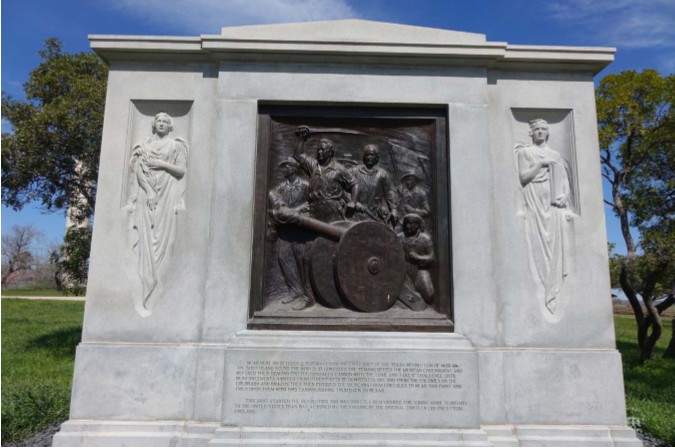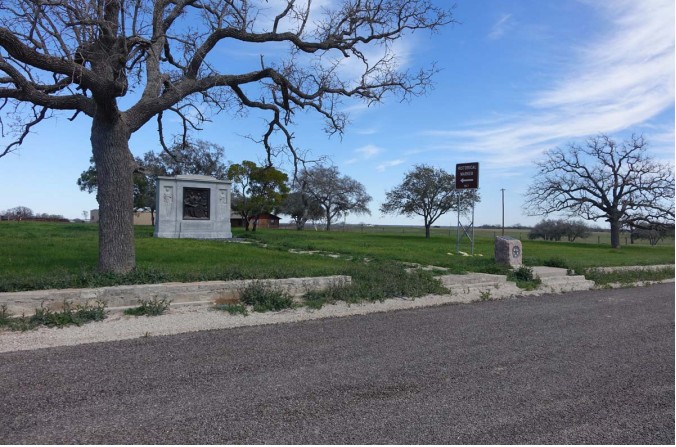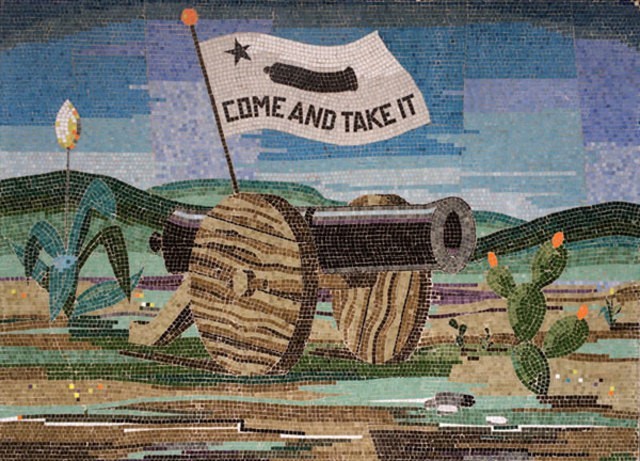The Battle of Gonzales
Introduction
Text-to-speech Audio
Images
1903 Monument

Centennial Monument

Roadside view of historical marker

Banner and Cannon

Backstory and Context
Text-to-speech Audio
Prior to Texas being part of the United States it belonged to Mexico. During the year 1835, Anglos who were living in Gonzales were mostly loyalists who still supported the Mexican president Santa Anna. However, they became aware of his dictatorial power because his efforts were to change the government of Mexico from a federalist system to a centralist one. Also during that time people immigrated to Texas and wanted this state to become part of the United States. The Anglos did not want to follow some of the things that the government imposed. For example, some of the causes that led to the battle were that the colonists were required to be Catholic, speak Spanish, had to buy their necessaries from Mexican dealers because commerce with the United States was prohibited, and they could not own slaves. Other problems too started to emerge in Gonzales by Native Americans, the Comanches that raided throughout white-settled areas in Texas. The Comanche raids started to occur with more frequency and became more serious and had the settlers with constant fear. In 1826 there was an attack that burned down of Gonzales. Eventually, the town was rebuilt and here Green Dewitt, a veteran of the War of 1812, requested a loan for the town from the political chief for the Department of Bexar, Ramon Musquiz. The request was for a small bronze six-pounder cannon to have for defense against the Indian raids. Part of the agreement was to return the cannon when the Texians would be asked.
Four years later Ramon Musquiz asked for the return of the canon because it was an excuse to capture the town. The townspeople rejected the idea that they would not return the cannon, the main reason was because of the dictates of the governor of Mexico. This made Mexico angry and so they decided to send about one hundred Mexican Dragoons to recapture the cannon back. After much discussion across the Guadalupe River, the Mexican troops moved to where the river was shallower. Meanwhile, the Texians were preparing for what they thought would be an outbreak of a war. They dug up the cannon and put wheels on it from a wooden wagon. The Texians started to fill it with pot legs and scrap iron by cutting chains and started shaping them as iron balls. A significant banner was made from a dress of Sarah DeWitt who was the wife of Green Dewitt. The words inscribed were, “COME AND TAKE IT,” on a white flag with a Black cannon. The Texians selected this message because they wanted to represent a strong action and fight for their liberty. So, on the morning of October 2, 1835, the Texians fired the cannon but were unable to see well because of the heavy fog. The Mexicans also returned the fire without being able to see. After refusing to surrender, the Texians shot the cannon, killing two Mexican soldiers. One Texian was injured when he fell from his horse and got a bloody nose.
It may not have been a big battle, because the losses were minimal, but it was the first opening battle of the Texas Revolution. After the battle, the Texians sought to fight seeking independence from Mexico. After many years Texas would become part of the United States, which gained 525,000 square miles of territory.
In 1903 construction of the monuments began in the approximate site of the cannon. This was because soon after the battle, a man named Jacob Darst who died defending the Alamo had shown his son David Darst the site where the first shots were fired. After David Darst shared the location of the site of the battle the townspeople got inspired to build the first monument along with students from Gonzales and were able to accomplish this monument. The town of Gonzales is known as the “Lexington of the Lone Star State,” because the first battle of the Texas Revolution was fought there. To this day, citizens of Gonzales gather together to celebrate this remembrance of their Texas heritage. The property of the monuments stretches to approximately 7.5 acres and includes many monuments. One of the monuments is called the Centennial Monument which is located as the centerpiece of the park and has a three-part composition. The center has six Texians behind a small cannon, on the left a woman with a laurel branch signifying victory, and on the right is a woman with a book marking a page which could be representing the first shot's place in history.
Sources
Bennet, Miles S. "The Battle of Gonzales, the "Lexington" of the Texas Revolution." Quarterly of the Texas State Historical Association 2, no. 4 (1899): 313-16. Accessed March 9, 2021. http://www.jstor.org/st able/30242776.
Calore, Paul. The Texas Revolution and the U.S.-Mexican War : A Concise History. Jefferson, North Carolina: McFarland & Company, 2014.
Crager, Kelly E. "Gonzales, Battle Of." Encyclopedia of the Mexican-American War: A Political, Social, and Military History. New York: ABC-CLIO, 2013.
From the Houston (Texas) Telegraph, May 1. "A Leaf From the Past: The Texas Revolution--The Causes that Led to it," New York Times, May 9, 1870.
“Old Brass Cannon-Will Roar.” Coolidge Examiner (Coolidge, AZ), September 13, 1935. https://chroniclingamerica.loc.gov/lccn/sn94050542/1935-09-13/ed-1/seq-5/
"First Shot Monuments Historic District, Cost, Gonzales County, Texas." National Park Service / National Register of Historic Places, United States Department of the Interior. https://www.thc.texas.gov/public/upload/preserve/national_register/final/Cost%2C%20First%20Shot%20Monuments%20HD%20NR.pdf
United States Department of the Interior. National Park Service / National Register of Historic Places, First Shot Monuments Historic District, Cost, Gonzales County, Texas. Microsoft Word - Cost, First Shot Monuments HD NR (texas.gov)
United States Department of the Interior. National Park Service / National Register of Historic Places, First Shot Monuments Historic District, Cost, Gonzales County, Texas. Microsoft Word - Cost, First Shot Monuments HD NR (texas.gov)
United States Department of the Interior. National Park Service / National Register of Historic Places, First Shot Monuments Historic District, Cost, Gonzales County, Texas. Microsoft Word - Cost, First Shot Monuments HD NR (texas.gov)
https://alchetron.com/Battle-of-Gonzales#battle-of-gonzales-d0196759-5925-4ce8-b7c7-b84c256cc09-resize-750.jpeg
